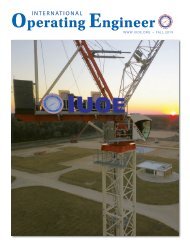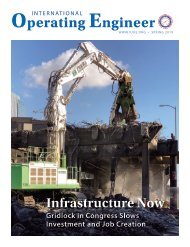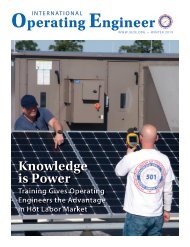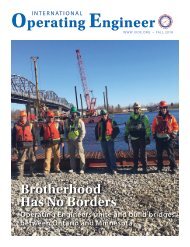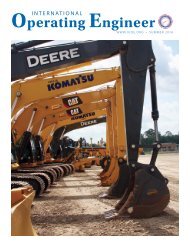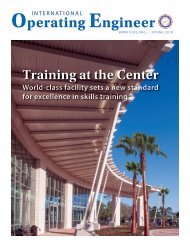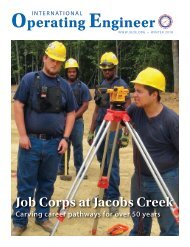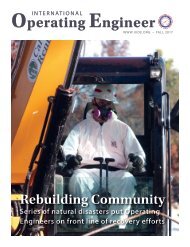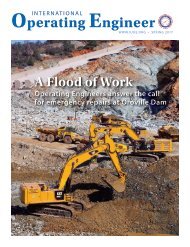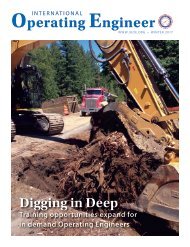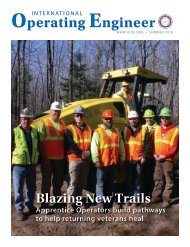125 Years Strong – An IUOE History
Celebrating the 125th Anniversary of the founding of the International Union of Operating Engineers
Celebrating the 125th Anniversary of the founding of the International Union of Operating Engineers
You also want an ePaper? Increase the reach of your titles
YUMPU automatically turns print PDFs into web optimized ePapers that Google loves.
INTERNATIONAL UNION OF OPERATING ENGINEERS<br />
Educating Young People<br />
PROUDLY PARTICIPATING IN JOB CORPS<br />
The I.U.O.E. National Training Fund has partnered with Job Corps,<br />
a national career-training program for young people ages 16 through<br />
24, since the early 1970s. As such, the union in 2021 has training<br />
agreements with the U.S. Departments of Labor and Agriculture to<br />
administer and operate pre-apprenticeship training programs at<br />
various Job Corps training centers throughout the United States.<br />
Through Job Corps, the I.U.O.E. has trained thousands of<br />
young adults as pre-apprentices in the fields of heavy-equipment<br />
operation, heavy-equipment mechanics, stationary engineering<br />
and asphalt paving. As of 2020, the union had provided career<br />
technical training to more than 380 students annually at 10<br />
I.U.O.E. Job Corps centers across the nation, each staffed with<br />
local union members.<br />
Continuously improving and updating equipment, tools and<br />
curriculum in order to meet the training needs of the ever-changing<br />
construction and mechanic industries, in 2018 the I.U.O.E. Job<br />
Corps program expanded at the Turner Job Corps Center in<br />
Albany, Georgia, becoming home to three trade offerings and<br />
five Job Corps instructors. Along with the <strong>An</strong>aconda Job Corps<br />
Center in <strong>An</strong>aconda, Montana, the Turner site became the second<br />
location to house five programs, creating the largest presence that<br />
the I.U.O.E. National Training Fund had at the time at any Job<br />
Corps training facility.<br />
Members of I.U.O.E. Local No. 14 in Flushing, New York, help erect the first of two towers of the original World<br />
Trade Center in New York City’s Manhattan district beginning in 1968. When completed in 1972 and 1973, the<br />
“Twin Towers” were the tallest buildings in the world. (Library of Congress, Prints & Photographs Division,<br />
U.S. News & World Report Magazine Collection [reproduction number, e.g., LC-U9-15739, frame 18].)<br />
Construction of the 1,368-foot-tall “North<br />
Tower” (officially 1 World Trade Center) began<br />
in August 1968 and was topped-out with a<br />
final steel beam on December 23, 1970; and<br />
erection of the 1,362-foot-tall “South Tower”<br />
(2 World Trade Center) was under way by<br />
January 1969 and was topped-out on July 19,<br />
1971. With I.U.O.E. engineers at the forefront<br />
of construction, the twin towers would set a<br />
new world record for building height, which<br />
for nearly 40 years had belonged to the Empire<br />
State Building, and signaled a new era in<br />
skyscraper construction.<br />
Pulled Down from New Highs<br />
Enormous expansion of work in the<br />
construction industry that had spurred<br />
I.U.O.E. growth during the 1960s<br />
continued to propel the union forward into<br />
the early 1970s. The high proportion of the<br />
nation’s construction expenditures that were<br />
invested in highway, airport, reclamation,<br />
suburban housing, industrial park and earthmoving<br />
projects were particularly important<br />
to operating engineers’ robust employment<br />
conditions in the new decade. (2)<br />
With the Vietnam War persisting and many<br />
of its members still in southeast Asia in combat<br />
and construction roles, the international<br />
entered 1970 somewhat leery, however, as<br />
national unemployment was rising and would<br />
hit 5.5 percent before the year was out. But<br />
aside from several federal legislative setbacks<br />
in 1970 and 1971 instigated by the President<br />
Richard M. Nixon administration, the union<br />
construction industry did set up a threeparty<br />
Construction Industry Stabilization<br />
Committee, with General President Wharton<br />
named as a labor member, that was empowered<br />
to review all construction-contract wage raises.<br />
Additionally, the federal Occupational Health<br />
and Safety Act of 1970 was signed into law<br />
at year’s end, establishing and enforcing job<br />
safety and health standards going forward,<br />
LABOR OMNIA VINCIT<br />
WORK CONQUERS ALL



